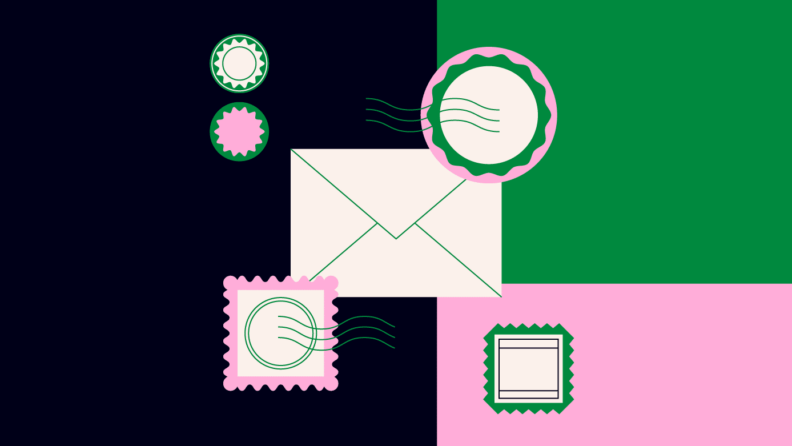We live in a world run by digital content and technology. Whether it's social media, television, website banner ads or electronic billboards, digital marketing experts estimate that most Americans are exposed to around 4,000 to 10,000 ads each day. People are craving physical contact, and as a business, it’s important you keep a human, tactile element to your brand.
This can be as simple as getting back to more traditional tactics, and direct marketing by mail may just be your ticket. In this article, I'll share its potential, why it's still relevant today and how to refine your strategy. I'll also help you navigate direct mail marketing software and automation for real results.
What is Direct Mail Marketing?
Direct mail marketing is a strategy that mails physical content and marketing materials to a person’s residence or business. Examples of this can include:
- handwritten or signed letters and invitations
- postcards or brochures
- product samples
- corporate swag
- even sometimes perishable items like fruit baskets and sweets
When I worked for a hospital foundation, I saw the deep personal connection between donors and the healthcare services that saved their life or that of a loved one. The time and care spent on the design and detail of our direct mail materials was appreciated by the recipients, strengthening the connection.
Is Direct Mail Marketing Dead?
In spite of a growing movement towards digital content, direct mail marketing is not dead. In fact it has evolved, becoming more exclusive and special to those receiving it.
As mentioned in the intro, people are desiring physical contact and objects more than ever—content that they can touch and feel.
But how can this benefit your business? Well, there are a number of big benefits for your marketing goals, such as:
It’s More Memorable
People remember marketing materials that they can hold in their hands or put on their desk—as opposed to the ephemeral images of digital content.
Whether it’s a new product, an invitation, or a mailer, they remember physical details like the texture of the paper or the weight of a box. They remember the ribbon used on the invitation or the signature of the CEO.
If kept around the home or business, your direct mail marketing materials will be a regular reminder of your brand and marketing message.
There’s Less Competition
More than 300 billion emails are sent every, single, day. When you incorporate all the online advertising and social media we consume, that’s a massive amount of digital content.
Just think about how much you are exposed to on a single web page—you have the article itself, but then you might also have ads (pop-up and static), social media links, instant messaging, videos, and images.
When you reach out to your customer base with direct mail marketing, there is considerably less competition—less noise—in your physical mailbox. There is more potential to stand out, grabbing the attention of the targeted audience member and whatever marketing outcome is desired.
It’s also been stated that direct mail marketing takes 21% less cognitive effort to process, making it an attention-grabbing and responsive tool.
Personalization
Be it a handwritten postcard or signed initials from someone in your company, direct mail materials can be personalized more than their digital counterparts, making them more memorable and therefore effective.
Direct mail marketing can be more creative and open, resulting in more options to connect with your audience and more options to add your individual touch. Take advantage of this. It’s not only an opportunity to take some risk, but also a chance to be innovative in your customer outreach and connection.
When personalizing your direct mail materials, go beyond just adding a customer’s first name. Look at what interests or concerns them, incorporating that into the direct mail content making it more relevant.
Better Response Rates
Because of the points above, direct mail has better response rates with studies reporting that 62% of consumers took action after reading a direct mail piece. Not only that, but 44% said direct mail is their primary channel for unknown brands. It is much more compelling to receive a piece of physical mail than one of many emails in your inbox.
Improved Brand Awareness
The efforts of your direct mail campaign will increase awareness of your brand and what it does. Successful direct mail campaigns can positively impact the reputation and image of an organization and how it is perceived by the public.
How To Refine Your Direct Mail Marketing Strategy In 2024
Knowing that direct mail marketing is effective, it’s time to look at how to refine your strategy for best results.
Use Data To Segment Audiences
Audience segmentation includes grouping your customers according to common characteristics, empowering you to customize marketing to specific people. Data segmentation can help you be ultra-specific about the content and collateral you send to your subscribers and customers.
According to Indeed.com, data segmentation has several benefits such as:
- increased lead conversions
- increased customer engagement
- improved product development
- stronger customer retention
Personalize and Customize
Personalization and customization are incredibly important to successful direct mail marketing. Once you’ve performed audience segmentation, personalize the content as much as possible to those characteristics; the right message sent to the right person at the right time is powerful.
This can help build an emotional connection with your brand, as when certain stories or images resonate deeply with people, they're more likely to remember or even share them. The personal connection comes in your attention to detail.
Use Creative, Eye-Catching Design
Because direct mail marketing is not limited to two-dimensional content, it allows you to be incredibly creative with your designs and modes for content.
Embrace this opportunity to try things that would be impossible with digital marketing materials. As a marketer, I really enjoyed this aspect of direct mail marketing and the freedom to be adventurous and innovative with deliveries.
Test First With Small Batch Sends
Before you order print marketing materials and designs en masse, we recommend that you first test them with a small batch mail-out. This allows you to see what resonates most, and how it can be improved in the future.
This is a chance to make sure it works before you commit the majority of your funding and resources. As an added bonus, it can help keep things more environmentally friendly and sustainable, as you won’t be producing and sending potentially ineffective marketing materials in large quantities.
Automate With A Sending Platform
Personally, I have spent entire evenings stuffing envelopes and adding addresses to small packages. While it was always worth it in the end, there are now a number of great options for direct mail automation software and some great direct mail service providers. These include:
Depending on your marketing budget, direct mailers can be incredibly valuable when implementing an effective direct mail marketing campaign.
Take A Multi-Channel Approach
Direct mail marketing on its own is a powerful marketing tool, but when integrated with other complementary channels in your marketing plan, it can strengthen customer relationships and trust.
Explore each of your available channels to determine if your customers are actively using it, structuring your marketing campaign around each channel’s strengths. These can include print, TV and radio media, face-to-face interaction or events, social media, online ads, your website, and email.
Track and Measure Results
Beyond your initial test batch, continue to track and measure the results and open rate of your direct mail campaigns. This can be performed in several ways, such as through campaign-specific URLs, promo codes, and QR codes that are only accessible on your direct mail materials.
Follow Up and Nurture Leads
It's one thing to build a relationship with a customer and it's another to maintain that relationship. Nurturing leads that come from your direct mail marketing campaign is key to the end goal (sales) and long-term success.
After implementing a direct mail strategy, follow-up must be performed with the customer to determine if their needs have been met or if anything else can be done to make them happier. This will make the customer feel connected to and appreciated by your brand.
Direct Mail Marketing FAQs And Answers
What’s The Cost Of Direct Mail?
The costs of direct mail marketing have been estimated to range anywhere from $0.30 to more than $10 per person. That said, this can vary greatly depending on a number of factors such as:
- the size and weight of the materials
- the number of people the direct mail will be sent to
- the locations of where the mail will be sent
- postage rates
- copywriting and design costs
How Can You Measure Direct Mail Campaign ROI?
Researchers have found that companies measured their direct mail return on investment (ROI) by monitoring the following metrics:
- individual activity within a specific time period (46%)
- QR code (41%)
- personalized URL (37%)
- order for featured products/services (36%)
- coupon code (34%)
- dedicated phone number (30%)
- a generic URL (28%)
Sendoso says that the ROI of your direct mail campaign can be calculated by dividing the net profit by your total campaign investment and multiplying that by 100 (ROI = Net Profit / Total Investment * 100).
While more expensive than email campaigns, direct mail campaigns can be very cost-effective as well as personal.
What Are The Steps To Create A Direct Mail Marketing Campaign?
1: Define your target audience
Who are you trying to speak to and connect with? Consider things like:
- age
- gender
- location
- hobbies
- income
- education level
- profession
- marital status
2. Create a mailing list
Make sure you have a reliable list of mailing addresses and contact information for your contacts and customers. If you already have a list, now’s the time to update it and make sure it is current and accurate for best results.
3. Find opportunities for connection
When determining what marketing materials to send, choose items and a piece of mail they will use and hold onto, as well as items that might resonate with them personally. What could they use around their home or office?
4. Determine call to action
Unlike digital marketing, direct mail does not have easy linking or other media to click on. When determining the CTA for your direct mail campaign, choose simple ones for the customer to fill out like a survey with a prepaid envelope or clicking the link from a provided QR code to a specific landing page.
5. Send, Track, and Optimize!
Use your preferred direct mail marketing software to get everything sent out, and track the results. As I mentioned above, you can do a small-batch test first, then optimize based on those results before investing all your resources.
Who can benefit from direct mail marketing?
With the costs of direct mail marketing, the scale of the campaigns range greatly from organization to organization, but are achievable for almost any budget. Because there are a number of different costs, there are also a number of opportunities to make adjustments to the budget and expenses.
Organizations that prioritize the relationship with their customers should leverage direct mail marketing as a way to retain those relationships over time.
Build Long-Term Relationships
No matter what your marketing goals are or what the CTA is, direct mail marketing is about building long-term relationships with your customers, helping build brand awareness and trust.
Email marketing has its strengths, however, successful direct mail campaigns will have deeper, longer-lasting impact on your target audience. It's a tried-and-true strategy with a personal touch that will be remembered long after the campaign is over. Be creative and your marketing efforts will be rewarded!
Want more? Be sure to subscribe to The CMO newsletter for more marketing news, trends, proven strategies and techniques.


